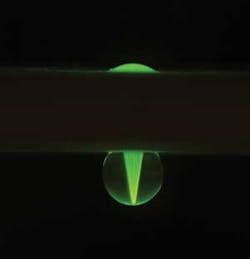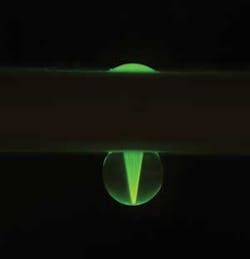VARIFOCAL OPTICS: Oscillating liquid lens focuses in a hundredth of a second

Millimeter-size spheres of water driven back and forth like a harmonic oscillator can effectively capture high-quality video and images with much faster focusing than conventional methods—without moving any solid parts—say researchers at Rensselaer Polytechnic Institute (Troy, NY). In conventional autofocus cameras, the mechanical focusing mechanism delays the recording of the image, sometimes considerably, from the time the shutter button is pressed. Amir Hirsa, professor of engineering at Rensselaer, and Carlos López, previously a graduate student at Rensselaer and now at Intel Platform Technologies (Jalisco, Mexico), developed a solution to that delay with an oscillating liquid lens that changes the mechanical focusing function into an electrical one, which can therefore capture images much more quickly than conventional shutters. Such adaptive liquid lenses are of interest for high-performance consumer products for their light weight, low cost, and low power requirements.
Hirsa and López stumbled upon the idea a few years ago while studying capillary instability and its use in energy-efficient actuation. While working on a capillary switch in an overfilled hole in a hydrophobic plate, Hirsa noticed “what a wonderful lens they produce” (see figure). “Driving these pinned-contact liquid lenses sinusoidally was a natural extension of that work,” he says. “We realized that a fast-enough oscillation sets up a resonant frequency so that the lens is nearly always in focus at any given time. Because it takes very little energy to sustain their motion, we wanted to create a lens that focuses nearly instantaneously,” says Hirsa.
Smaller droplets, higher speed
The liquid lens consists of two droplets flowing back and forth through a cylindrical hole in a Teflon substrate, which keeps the contact line between water, air, and Teflon pinned to the opening of the cylinder. An acoustic speaker produces a pressure wave not exceeding 25 Pa (2.5 × 10-4 atm) for a 1-mm-scale lens, driving the lens at its lowest harmonic frequency in and out of focus at approximately 100 Hz. A high-speed camera directed lengthwise through the cylinder is synchronized with the pressure wave, enabling up to 100 images per second—and even faster with smaller-diameter droplets. The team estimates that a 10 µm droplet could produce resonant frequencies of 100,000 Hz, barring any unforeseen effects arising, such as a significant increase in viscous dissipation.
“Like most lenses,” says Hirsa, “the oscillating liquid lens can be used for either still or video imaging.” The quality can be significantly better than a fixed-focus lens when imaging an object not at the focal plane of the lens. With the pinned-contact oscillating liquid lens, a sharp image can be obtained several times per second, no matter where the object is, because the focal plane is being rapidly scanned. Furthermore, the liquid oscillating lens has potential in three-dimensional imaging. Different planes of a three-dimensional object could be captured by a high-speed camera as they become focused during a single oscillation of the lens, allowing a deconvolved reconstruction.
To develop a commercially viable lens for applications that require a fast focus, such as mobile phones and lightweight camcorders, the next step for the team is to address packaging issues. These include developing a lens system that is resistant to mechanical shock and solving the problem of evaporative losses, possibly with a liquid/liquid system rather than a gas/liquid system.
REFERENCE
- C.A. López et al., Nature Photonics advanced online publication, Sept. 21, 2008, doi: 10.1038/nphoton.2008.198.
About the Author
Valerie Coffey-Rosich
Contributing Editor
Valerie Coffey-Rosich is a freelance science and technology writer and editor and a contributing editor for Laser Focus World; she previously served as an Associate Technical Editor (2000-2003) and a Senior Technical Editor (2007-2008) for Laser Focus World.
Valerie holds a BS in physics from the University of Nevada, Reno, and an MA in astronomy from Boston University. She specializes in editing and writing about optics, photonics, astronomy, and physics in academic, reference, and business-to-business publications. In addition to Laser Focus World, her work has appeared online and in print for clients such as the American Institute of Physics, American Heritage Dictionary, BioPhotonics, Encyclopedia Britannica, EuroPhotonics, the Optical Society of America, Photonics Focus, Photonics Spectra, Sky & Telescope, and many others. She is based in Palm Springs, California.


